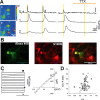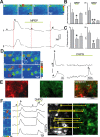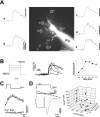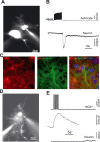Sensory and cortical activation of distinct glial cell subtypes in the somatosensory thalamus of young rats
- PMID: 20608967
- PMCID: PMC2909395
- DOI: 10.1111/j.1460-9568.2010.07281.x
Sensory and cortical activation of distinct glial cell subtypes in the somatosensory thalamus of young rats
Abstract
The rodent ventrobasal (VB) thalamus receives sensory inputs from the whiskers and projects to the cortex, from which it receives reciprocal excitatory afferents. Much is known about the properties and functional roles of these glutamatergic inputs to thalamocortical neurons in the VB, but no data are available on how these afferents can affect thalamic glial cells. In this study, we used combined electrophysiological recordings and intracellular calcium ([Ca(2+)](i)) imaging to investigate glial cell responses to synaptic afferent stimulation. VB thalamus glial cells can be divided into two groups based on their [Ca(2+)](i) and electrophysiological responses to sensory and corticothalamic stimulation. One group consists of astrocytes, which stain positively for S100B and preferentially load with SR101, have linear current-voltage relations and low input resistance, show no voltage-dependent [Ca(2+)](i) responses, but express mGluR5-dependent [Ca(2+)](i) transients following stimulation of the sensory and/or corticothalamic excitatory afferent pathways. Cells of the other glial group, by contrast, stain positively for NG2, and are characterized by high input resistance, the presence of voltage-dependent [Ca(2+)](i) elevations and voltage-gated inward currents. There were no synaptically induced [Ca(2+)](i) elevations in these cells under control conditions. These results show that thalamic glial cell responses to synaptic input exhibit different properties to those of thalamocortical neurons. As VB astrocytes can respond to synaptic stimulation and signal to neighbouring neurons, this glial cell organization may have functional implications for the processing of somatosensory information and modulation of behavioural state-dependent thalamocortical network activities.
Figures









Comment in
-
Diversity and specificity of glial cell responses in the thalamus (commentary on Parri et al.).Eur J Neurosci. 2010 Jul;32(1):27-8. doi: 10.1111/j.1460-9568.2010.07328.x. Eur J Neurosci. 2010. PMID: 20608966 No abstract available.
Similar articles
-
Glutamatergic input-output properties of thalamic astrocytes.Neuroscience. 2012 Mar 15;205:18-28. doi: 10.1016/j.neuroscience.2011.12.049. Epub 2012 Jan 3. Neuroscience. 2012. PMID: 22233780 Free PMC article.
-
Synapse- and subtype-specific modulation of synaptic transmission by nicotinic acetylcholine receptors in the ventrobasal thalamus.Neurosci Res. 2011 Mar;69(3):203-13. doi: 10.1016/j.neures.2010.12.002. Epub 2010 Dec 9. Neurosci Res. 2011. PMID: 21145925
-
Roles of mGluR5 in synaptic function and plasticity of the mouse thalamocortical pathway.Eur J Neurosci. 2009 Apr;29(7):1379-96. doi: 10.1111/j.1460-9568.2009.06696.x. Epub 2009 Mar 23. Eur J Neurosci. 2009. PMID: 19519626 Free PMC article.
-
Distinct properties of corticothalamic and primary sensory synapses to thalamic neurons.Neurosci Res. 2007 Dec;59(4):377-82. doi: 10.1016/j.neures.2007.08.015. Epub 2007 Aug 31. Neurosci Res. 2007. PMID: 17920147 Review.
-
Novel neuronal and astrocytic mechanisms in thalamocortical loop dynamics.Philos Trans R Soc Lond B Biol Sci. 2002 Dec 29;357(1428):1675-93. doi: 10.1098/rstb.2002.1155. Philos Trans R Soc Lond B Biol Sci. 2002. PMID: 12626003 Free PMC article. Review.
Cited by
-
Activity dependent modulation of glial gap junction coupling in the thalamus.iScience. 2024 Sep 26;27(10):111043. doi: 10.1016/j.isci.2024.111043. eCollection 2024 Oct 18. iScience. 2024. PMID: 39435144 Free PMC article.
-
Neuron-glia networks: integral gear of brain function.Front Cell Neurosci. 2014 Nov 6;8:378. doi: 10.3389/fncel.2014.00378. eCollection 2014. Front Cell Neurosci. 2014. PMID: 25414643 Free PMC article. Review.
-
Characterization of Panglial Gap Junction Networks in the Thalamus, Neocortex, and Hippocampus Reveals a Unique Population of Glial Cells.Cereb Cortex. 2015 Oct;25(10):3420-33. doi: 10.1093/cercor/bhu157. Epub 2014 Jul 17. Cereb Cortex. 2015. PMID: 25037920 Free PMC article.
-
GABA(B) receptor-mediated activation of astrocytes by gamma-hydroxybutyric acid.Philos Trans R Soc Lond B Biol Sci. 2014 Oct 19;369(1654):20130607. doi: 10.1098/rstb.2013.0607. Philos Trans R Soc Lond B Biol Sci. 2014. PMID: 25225100 Free PMC article.
-
Glutamatergic input-output properties of thalamic astrocytes.Neuroscience. 2012 Mar 15;205:18-28. doi: 10.1016/j.neuroscience.2011.12.049. Epub 2012 Jan 3. Neuroscience. 2012. PMID: 22233780 Free PMC article.
References
-
- Barbaresi P, Spreafico R, Frassoni C, Rustioni A. GABAergic neurons are present in the dorsal column nuclei but not in the ventroposterior complex of rats. Brain Res. 1986;382:305–326. - PubMed
-
- Bergles DE, Roberts JD, Somogyi P, Jahr CE. Glutamatergic synapses on oligodendrocyte precursor cells in the hippocampus. Nature. 2000;405:187–191. - PubMed
Publication types
MeSH terms
Substances
Grants and funding
LinkOut - more resources
Full Text Sources
Research Materials
Miscellaneous

